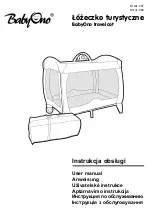
Power Management States and BIOS Configuration Options
6-5
Power Management States and BIOS Configuration Options
6
The system power states utilized by your system depend on how power management options are
configured in the BIOS. System power states and BIOS options that affect each state are described in this
section.
Note:
Power management state transitions can also be controlled by Windows. Some of the power management
features and states described in this section function differently when APM or ACPI is active. Refer to
your operating system documentation for details on configuring ACPI controls.
Timeouts
6
Timeouts for the Idle, Standby, and Suspend states are configured in the BIOS. (A timeout is the period of
time that must elapse with no activity before the transition occurs.) In addition to overall system power
states, power for some devices can be individually managed through timeouts configured in the BIOS
such as the hard disk drive spin-down timeout.
Fully On State
6
In the Fully On state, all devices are fully powered and the CPU runs at full speed. The system is in the
Fully On state whenever user activity is detected. The system will remain in the Fully On state until an
event such as the idle mode timeout or a suspend request occurs. Note that if Idle and Standby modes are
not utilized, the system will remain in the Fully On state until an event such as a suspend request causes
a transition out of the Fully On state.
Idle Mode
6
When the Idle Mode Timeout BIOS option is enabled, the system will enter Idle mode after a period of
1/2 second with no activity. The system also runs in Idle mode (and does not use the Fully On state)
under the following conditions regardless of the Idle Mode Timeout setting:
• When operating on battery power under the Low Battery or Very Low Battery conditions. (This
conserves battery power.)
• When the system temperature is High. (This reduces the internal temperature of the system.)
In Idle mode, internal CPU clock signals are “throttled” or periodically switched on and off achieving a
net reduction of the CPU speed which reduces the amount of power consumed by the CPU. This is done
by switching the Stop Grant signal of the CPU on and off. In turn, most internal CPU clock signals are
turned on and off.
Table 6-3 shows the activity of these signals in Idle and Standby modes. (The first dotted line in each
column of this table indicates when the timeout occurs and the mode is entered.) If user activity generates
Содержание stylistic lt
Страница 1: ...Stylistic LT Technical Reference Guide ...
Страница 6: ...vi ...
Страница 8: ...viii ...
Страница 10: ...x ...
Страница 14: ...xiv About This Guide ...
Страница 18: ...1 4 Stylistic LT Features ...
Страница 58: ...3 38 Configuring the Stylistic LT Pen Tablet System ...
Страница 68: ...4 10 Hardware Specifications ...
Страница 110: ...B 2 Enabling ACPI ...
Страница 124: ...D 10 Glossary ...
Страница 130: ...Index 6 ...
Страница 131: ......
Страница 132: ...8 99 58 0658 00A ...
















































